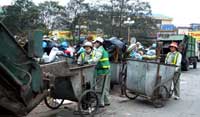INDOCHINA INTERNATIONAL CONSULTING CO., LTD
HO Add: 62L/36 Nguyên Hồng, Ward 11, Bình Thạnh District, HCMC - Vietnam
Biz Office Add: #48 Road No 11, Quarter 6, Hiệp Binh Chánh Ward, Thủ Đức, HCMC - Vietnam
®Source: http://viipip.com should be clearly quoted for any use of information extracted from our website.
Publication permit No: 60/GP-TTĐT , April 05, 2010.


Workers from Thang Long Joint Stock Company collect garbage on Tam Trinh street in Ha Noi. Solid waste has increased dramatically in urban areas while waste treatment systems remain incapable.
Solid waste has increased dramatically, while waste treatment systems remain incapable of dealing with the problem.
Nguyen Viet Anh, professor at the Ha Noi University of Civil Engineering said there are more than 740 urban areas in the country which are home to about 24 million of people, or 29 per cent of the population. Anh added only between 40 to 70 per cent of the urban areas were connected to sewer lines and just 10 per cent of waste water was treated.
Urban areas produce 6 million tonnes of solid waste per year, however more than 1 million urban households did not have their waste collected, Anh said.
The number, Anh said, speaks how polluted Viet Nam is through a lack of waste treatment facilities and, as a result, every year the country loses USD 780 million for that reason.
Chair of Wastewater Technology, Germany Martin Wagner, spoke about the semi-centralised supply and disposal systems (SDC) in urban areas as the best solution in Viet Nam, as it could protect natural resources by recycling water, as well as extracting nutrients which could be used for other purposes.
Vietnamese and German experts have taken Ha Noi as a case study as part of a co-operative project between the Ha Noi University of Civil Engineering and German Darmstadt University of Technology since last year. Most of the 6.3 million populated city use septic tanks to treat their toilet waste, which polluted underground water with ammonia, a gaseous compound of hydrogen and nitrogen. However it was impossible to replace the tanks due to the high costs, said Wagner.
Fertiliser
Adding to problem, the tradition of using untreated or simply treated waste as fertiliser put more people at risk of ill health, bringing a larger burden to the local health system budget, said Anh.
Experts from the two countries chose the SDC, which could enable the city not only to solve pollution from untreated waste, but also take advantage of valuable minerals such as nitre, phosphorus and potassium that Viet Nam currently imports at high prices.
Anh said with the semi-centralised system, they could save not only large amounts of useful biogas, but also produce about 3.4 million MWh of electricity per year, strengthening national energy security.
Viet Nam and Germany have implemented the waste water and solid waste management programme since 2005, at a cost of about 200 million euros, 40 million euros of which has been provided by Viet Nam, with the rest made up by German support.
Under the programme, the cities, provinces and districts of Bac Ninh, Hai Duong, Vinh, Can Tho, Tra Vinh, Soc Trang, Lang Son, Hung Yen, Ha Dong, Son Tay, Hoa Binh and Son La will carry out the project.
- FDI capital continues to pour into Vietnam (6/11/2025 1:20:33 PM)
- Thanh Hoa receives good news: Preparing to have an additional industrial park of up to 470 hectares, creating jobs for nearly 30,000 people (6/11/2025 1:15:09 PM)
- Industrial Park Real Estate: Waiting for the New Generation of FDI (6/11/2025 1:10:15 PM)
- A wealthy Vietnamese city will have two special economic zones after the merger (6/11/2025 1:04:42 PM)
- 30 billion USD capital FDI in Việt Nam by 2025, a series of "ông big" races to expand the land fund (6/11/2025 12:55:26 PM)
- the 2nd largest city in the North will start construction on an international economic zone (6/11/2025 12:50:20 PM)
- Japanese giant Sumitomo continues to want to build an industrial park in the countrys fourth smallest province. (6/11/2025 12:40:45 PM)
- 3 foreign corporations want to invest billions of dollars in Ba Ria - Vung Tau (6/11/2025 12:34:30 PM)
- Lotte Group member starts construction of nearly 1,000 billion VND logistics center in the province with the most industrial parks in Vietnam (6/11/2025 12:33:26 PM)
- Forming a regional center for manufacturing spare parts and components (6/11/2025 12:24:08 PM)
- Vietnams first wafer factory is about to start construction (6/11/2025 12:19:09 PM)
- Dong Nai attracts foreign investors (6/11/2025 12:13:27 PM)
- Tay Ninhs largest industrial park welcomes a $150 million high-end knitted fabric factory project (6/11/2025 12:11:00 PM)
- (6/11/2025 12:09:10 PM)
- Vietnam will become a destination for Chinese investors in the future (11/6/2023 1:03:19 PM)

- FDI capital continues to pour into Vietnam
- Thanh Hoa receives good news: Preparing to have an additional industrial park of up to 470 hectares, creating jobs for nearly 30,000 people
- Industrial Park Real Estate: Waiting for the New Generation of FDI
- A wealthy Vietnamese city will have two special economic zones after the merger
- 30 billion USD capital FDI in Việt Nam by 2025, a series of "ông big" races to expand the land fund










 ADB: Vietnam’s 2009 GDP growth to be highest in South East Asia
ADB: Vietnam’s 2009 GDP growth to be highest in South East Asia MGM Grand Ho Tram: Vietnam’s First ‘Las Vegas Style’ Integrated Resort
MGM Grand Ho Tram: Vietnam’s First ‘Las Vegas Style’ Integrated Resort Nha Trang’s Twin Towers project licenced
Nha Trang’s Twin Towers project licenced Foreign investors still have good opportunities in Vietnam
Foreign investors still have good opportunities in Vietnam Sierra Wireless gets a foot in Vietnam’s ICT market
Sierra Wireless gets a foot in Vietnam’s ICT market